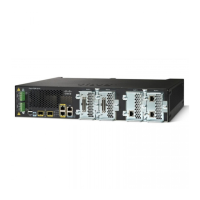31-25
Catalyst 3550 Multilayer Switch Software Configuration Guide
78-11194-09
Chapter 31 Configuring IP Unicast Routing
Configuring IGRP
Default IGRP Configuration
Table 31-6 shows the default IGRP configuration.
Routers running IGRP use flash and poison-reverse updates to speed up the convergence of the routing
algorithm. Flash updates are updates sent before the standard interval, notifying other routers of a metric
change. Poison-reverse updates are intended to defeat larger routing loops caused by increases in routing
metrics. The poison-reverse updates are sent to remove a route and place it in hold-down, which keeps
new routing information from being used for a certain period of time.
Understanding Load Balancing and Traffic Distribution Control
IGRP can simultaneously use an asymmetric set of paths for a given destination. This unequal-cost load
balancing allows traffic to be distributed among up to four unequal-cost paths to provide greater overall
throughput and reliability.
Alternate path variance (that is, the difference in desirability between the primary and alternate paths)
determines the feasibility of a potential route. An alternate route is feasible if the next router in the path
is closer to the destination (has a lower metric value) than the router being used, and if the metric for the
entire alternate path is within the variance. Only feasible paths are used for load balancing and are
included in the routing table. These conditions limit the number of load balancing occurrences, but
ensure that the dynamics of the network remain stable.
These general rules apply to IGRP unequal-cost load balancing:
• IGRP accepts up to four paths for a given destination network.
• The local best metric must be greater than the metric learned from the next router; that is, the next
hop router must be closer (have a smaller metric value) to the destination than the local best metric.
Table 31-6 Default IGRP Configuration
Feature Default Setting
IP split horizon Varies with media.
Metric holddown Disabled.
Metric maximum-hops 100 hops.
Neighbor None defined.
Network None specified.
Offset-list Disabled.
Set metric None set in route map.
Timers basic Update: 90 seconds.
Invalid: 270 seconds.
Hold-down: 280 seconds.
Flush: 630 seconds.
Sleeptime: 0 milliseconds.
Traffic-share Distributed proportionately to the ratios of the metrics.

